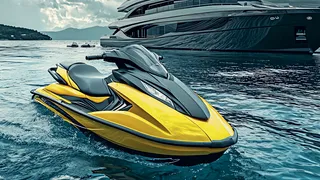An enjoyable day on the water can turn into a tragedy in an instant. Here are the dangers of towed watersports and toys.
It was the day after the yacht owner’s daughter’s birthday and the chase boat, a 42-foot Fjord, was full of teenage girls. On the hot and sunny Saturday in May, the girls were enjoying watersports in South Florida’s Biscayne Bay, about a mile west of Key Biscayne. At one point, the Fjord was towing two girls at the same time, one on a wakeboard and the other on a wake surfboard, and they fell in different locations. While they waited for pick-up in the water, a 42-foot Boston Whaler traveling west into the afternoon sun struck the wakeboarder, who was further away from the tender, and she died from her injuries.
The operator of the Boston Whaler was alone that day. By all accounts, he was an experienced boater, out for a short afternoon cruise. According to a witness, he never changed course, slowed down or stopped, and it came out that he only learned he had killed someone days later when investigators tracked down his boat.
One year later, the investigation is still ongoing by the Florida Fish and Wildlife Conservation Commission, so no further details are available. But the tragic accident serves as a grim reminder of the dangers of towed watersports and, specifically, how these dangers can be amplified when more than one person is being towed.
“Having multiple skiers/riders, of course, increases all risks and this should be identified in a risk assessment prior to the activity taking place. Ideally, it is best conducted on an enclosed waterway,” says Tim Hughes, a UK-based watersports consultant. “Any piece of water often used for transiting from one area to another, like a channel or a route from marina to open water, must be avoided. It’s not unusual for vessels fitted with autopilot to have that facility activated while the operator is otherwise occupied with rigging or de-rigging fishing equipment, for example, or preparing fenders and lines, and therefore not maintaining a proper lookout.”
A common scenario for towing multiple people is inflatables such as banana boats. A number of years ago, the UK’s Marine Accident Investigation Branch (MAIB) investigated a fatal accident that took place in a watersports park during a child’s birthday party. A Ski Nautique was towing 10 children on a banana boat and the driver did not notice when a lone girl fell off. Despite the efforts of parents watching from shore to get his attention, he continued on a circular route at a speed that caused a bow-up trim and reduced his forward visibility, and he ran over the girl.
A major contributor to that accident, said the MAIB report, was the fact that there was no designated observer in the boat. Tim calls the observer “a vital role” and notes that it should not be just a passenger who could get distracted.
Visibility in the water is a huge concern any time someone goes down. “Holding up a ski or board can aid visibility, as can wearing a bright [hi-vis] helmet. But it seems that most skis/boards/helmets tend to be black or carbon in color these days,” Tim says. In the banana boat incident, the child was wearing a gray foam helmet that the investigation later proved to be close to impossible to see in the shadow-cast water. The MAIB conducted trials with the helmet covered by a high visibility material and found the difference to be “considerable.”
Captain Kerry Titheradge (who always wears fluorescent orange when he eFoils) points out, “a little known rule is having an orange flag to notify boats that you have a skier in the water.” In many jurisdictions, it’s required to raise a bright orange flag, at least 12 inches square when a skier is down, preparing to ski or retrieving equipment.
The head of yacht management company Yachting Concepts and current Below Deck captain has learned in his 31 years on the water that close calls can happen far too easily.
“I prefer not to do watersports in areas of traffic,” Kerry says, “but before I decide if it’s a go or no-go, I’ll do a risk assessment of my environment, considering all of the vessel’s assets. If it’s a go, oftentimes I would put out one or two jet skis to play defense and act like a security perimeter around the guests. If someone comes off, the jet ski would stop next to that person, shielding them from any traffic, until the boat comes back around.”
That’s the ideal scenario for multiple skiers/riders, but failing that, he would instruct the guests that if one person comes off, the other must come off straight away. “Everybody falls in the same area,” he says.
The third option would be to tow one person at a time, which is the best choice in areas with traffic, he says. “If one person comes off, you can stop the boat straight away and protect them.”

